HRES2203 Case Study: Analyzing Henderson Printing's Reward System
VerifiedAdded on 2022/08/10
|8
|1563
|443
Case Study
AI Summary
This case study examines the management practices at Henderson Printing, a medium-sized manufacturer led by George Henderson. The analysis focuses on Henderson's democratic managerial style and its impact on employee compensation and motivation. The study identifies the pros and cons of the current reward strategy, which lacks a formal pay system and relies on subjective assessments. It then proposes a new reward strategy incorporating distinct base and variable pay, benefits, and development opportunities. The case study also outlines a compensation mix including base pay, indirect pay, and incentive pay, along with goals for the reward system, such as attracting talent and boosting motivation. Finally, it references the Employment and Labor Law of 2019 as relevant to the company's operations, providing a comprehensive overview of the firm's human resource management challenges and potential improvements.
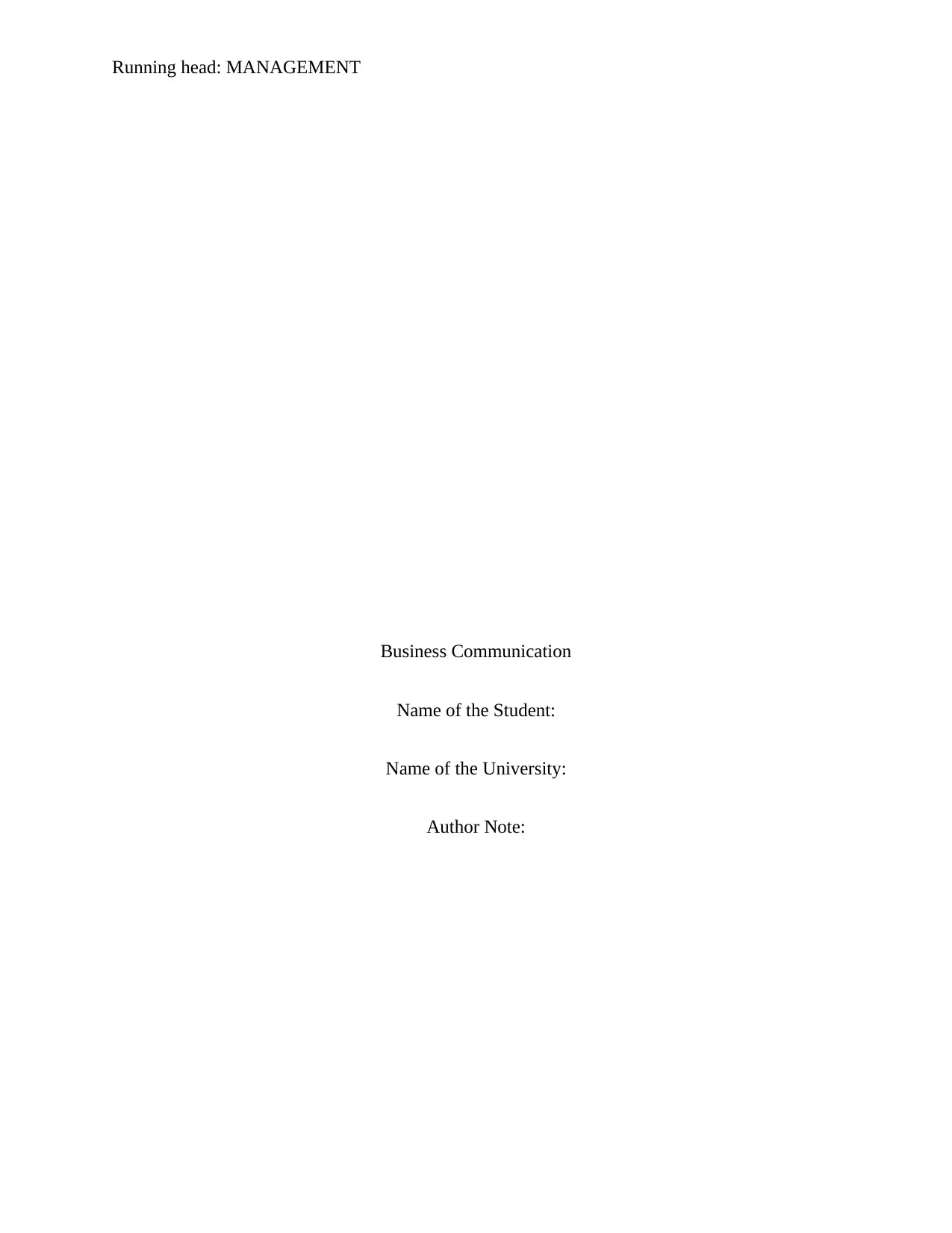
Running head: MANAGEMENT
Business Communication
Name of the Student:
Name of the University:
Author Note:
Business Communication
Name of the Student:
Name of the University:
Author Note:
Paraphrase This Document
Need a fresh take? Get an instant paraphrase of this document with our AI Paraphraser

1MANAGEMENT
Executive Summary:
The report provides an insight into present managerial style at Henderson Printing. The firm
found by George Henderson is located in Halifax and is a medium sized manufacturer of ledgers,
account books and different kinds of record books that most finds use in business. The owner of
the company firmly believes in producing higher quality products that has the ability of standing
up for many years of usage. Being a benevolent employer, George follows a democratic
managerial style. In this particular style, the manager reaches a decision with input from the
employees but holds the responsibility of making a final decision. This allows him to focus most
of the attention on ensuring the product quality and in dealing with countless problems that every
person consults with him on a day to day basis.
Executive Summary:
The report provides an insight into present managerial style at Henderson Printing. The firm
found by George Henderson is located in Halifax and is a medium sized manufacturer of ledgers,
account books and different kinds of record books that most finds use in business. The owner of
the company firmly believes in producing higher quality products that has the ability of standing
up for many years of usage. Being a benevolent employer, George follows a democratic
managerial style. In this particular style, the manager reaches a decision with input from the
employees but holds the responsibility of making a final decision. This allows him to focus most
of the attention on ensuring the product quality and in dealing with countless problems that every
person consults with him on a day to day basis.
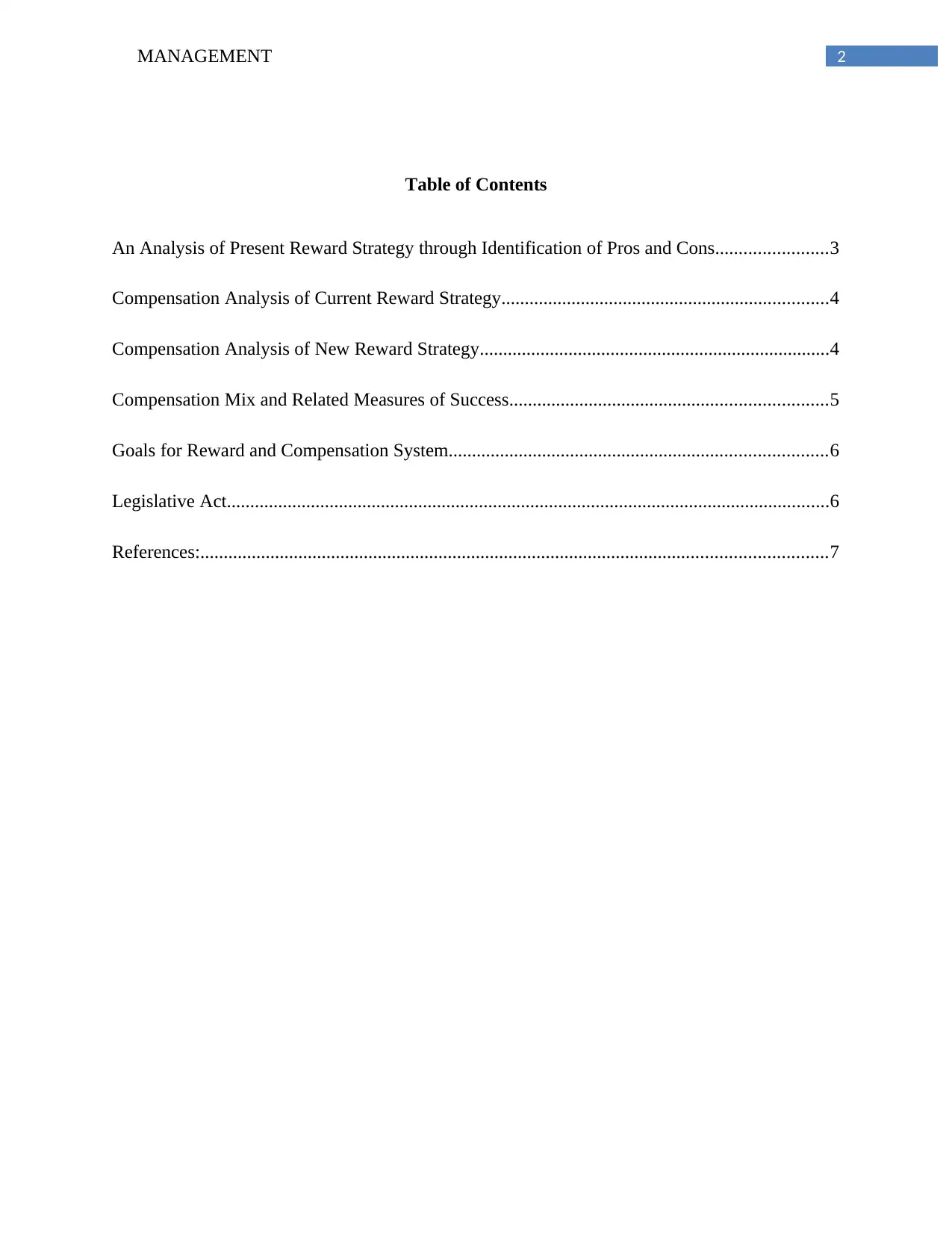
2MANAGEMENT
Table of Contents
An Analysis of Present Reward Strategy through Identification of Pros and Cons........................3
Compensation Analysis of Current Reward Strategy......................................................................4
Compensation Analysis of New Reward Strategy...........................................................................4
Compensation Mix and Related Measures of Success....................................................................5
Goals for Reward and Compensation System.................................................................................6
Legislative Act.................................................................................................................................6
References:......................................................................................................................................7
Table of Contents
An Analysis of Present Reward Strategy through Identification of Pros and Cons........................3
Compensation Analysis of Current Reward Strategy......................................................................4
Compensation Analysis of New Reward Strategy...........................................................................4
Compensation Mix and Related Measures of Success....................................................................5
Goals for Reward and Compensation System.................................................................................6
Legislative Act.................................................................................................................................6
References:......................................................................................................................................7
⊘ This is a preview!⊘
Do you want full access?
Subscribe today to unlock all pages.

Trusted by 1+ million students worldwide
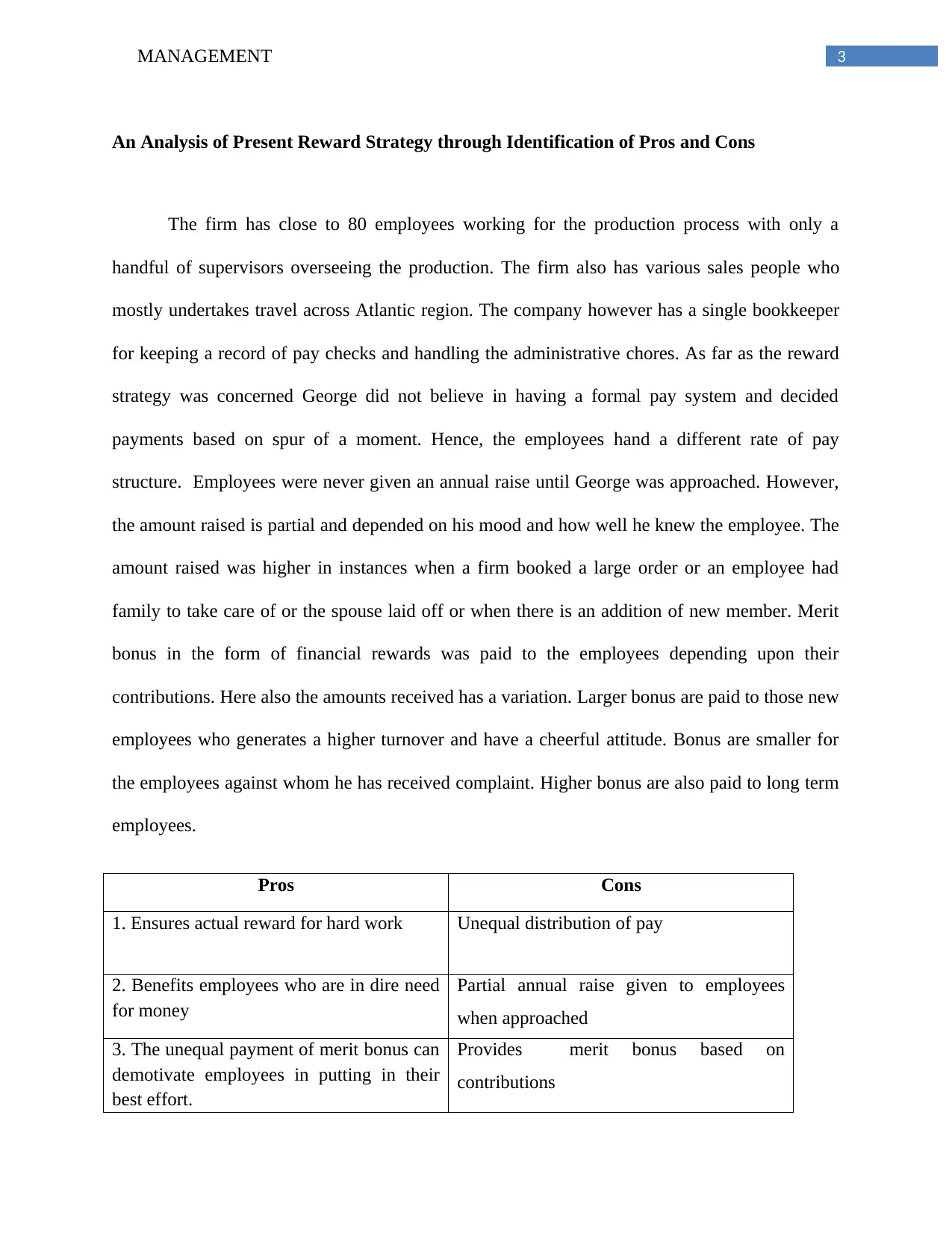
3MANAGEMENT
An Analysis of Present Reward Strategy through Identification of Pros and Cons
The firm has close to 80 employees working for the production process with only a
handful of supervisors overseeing the production. The firm also has various sales people who
mostly undertakes travel across Atlantic region. The company however has a single bookkeeper
for keeping a record of pay checks and handling the administrative chores. As far as the reward
strategy was concerned George did not believe in having a formal pay system and decided
payments based on spur of a moment. Hence, the employees hand a different rate of pay
structure. Employees were never given an annual raise until George was approached. However,
the amount raised is partial and depended on his mood and how well he knew the employee. The
amount raised was higher in instances when a firm booked a large order or an employee had
family to take care of or the spouse laid off or when there is an addition of new member. Merit
bonus in the form of financial rewards was paid to the employees depending upon their
contributions. Here also the amounts received has a variation. Larger bonus are paid to those new
employees who generates a higher turnover and have a cheerful attitude. Bonus are smaller for
the employees against whom he has received complaint. Higher bonus are also paid to long term
employees.
Pros Cons
1. Ensures actual reward for hard work Unequal distribution of pay
2. Benefits employees who are in dire need
for money
Partial annual raise given to employees
when approached
3. The unequal payment of merit bonus can
demotivate employees in putting in their
best effort.
Provides merit bonus based on
contributions
An Analysis of Present Reward Strategy through Identification of Pros and Cons
The firm has close to 80 employees working for the production process with only a
handful of supervisors overseeing the production. The firm also has various sales people who
mostly undertakes travel across Atlantic region. The company however has a single bookkeeper
for keeping a record of pay checks and handling the administrative chores. As far as the reward
strategy was concerned George did not believe in having a formal pay system and decided
payments based on spur of a moment. Hence, the employees hand a different rate of pay
structure. Employees were never given an annual raise until George was approached. However,
the amount raised is partial and depended on his mood and how well he knew the employee. The
amount raised was higher in instances when a firm booked a large order or an employee had
family to take care of or the spouse laid off or when there is an addition of new member. Merit
bonus in the form of financial rewards was paid to the employees depending upon their
contributions. Here also the amounts received has a variation. Larger bonus are paid to those new
employees who generates a higher turnover and have a cheerful attitude. Bonus are smaller for
the employees against whom he has received complaint. Higher bonus are also paid to long term
employees.
Pros Cons
1. Ensures actual reward for hard work Unequal distribution of pay
2. Benefits employees who are in dire need
for money
Partial annual raise given to employees
when approached
3. The unequal payment of merit bonus can
demotivate employees in putting in their
best effort.
Provides merit bonus based on
contributions
Paraphrase This Document
Need a fresh take? Get an instant paraphrase of this document with our AI Paraphraser
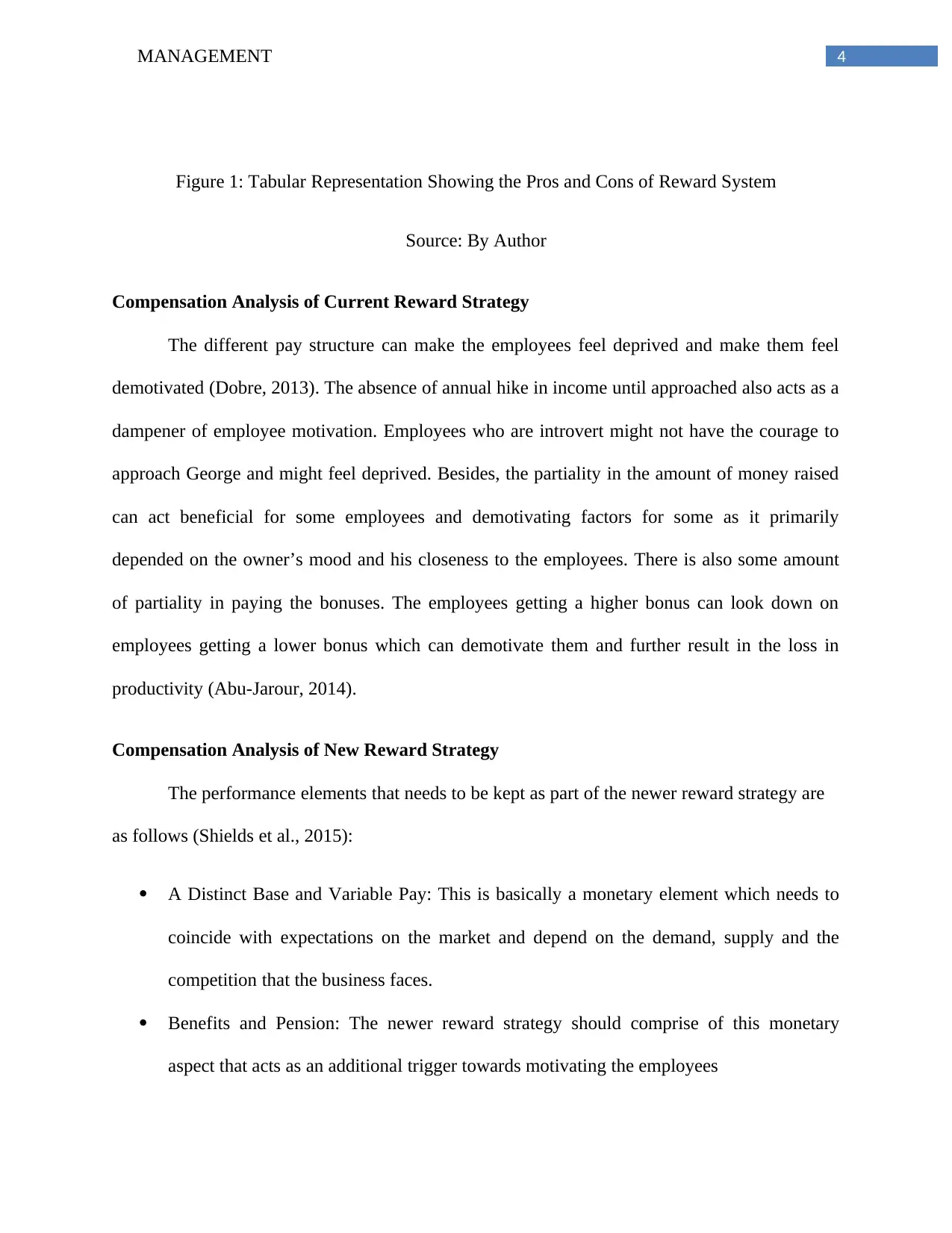
4MANAGEMENT
Figure 1: Tabular Representation Showing the Pros and Cons of Reward System
Source: By Author
Compensation Analysis of Current Reward Strategy
The different pay structure can make the employees feel deprived and make them feel
demotivated (Dobre, 2013). The absence of annual hike in income until approached also acts as a
dampener of employee motivation. Employees who are introvert might not have the courage to
approach George and might feel deprived. Besides, the partiality in the amount of money raised
can act beneficial for some employees and demotivating factors for some as it primarily
depended on the owner’s mood and his closeness to the employees. There is also some amount
of partiality in paying the bonuses. The employees getting a higher bonus can look down on
employees getting a lower bonus which can demotivate them and further result in the loss in
productivity (Abu-Jarour, 2014).
Compensation Analysis of New Reward Strategy
The performance elements that needs to be kept as part of the newer reward strategy are
as follows (Shields et al., 2015):
A Distinct Base and Variable Pay: This is basically a monetary element which needs to
coincide with expectations on the market and depend on the demand, supply and the
competition that the business faces.
Benefits and Pension: The newer reward strategy should comprise of this monetary
aspect that acts as an additional trigger towards motivating the employees
Figure 1: Tabular Representation Showing the Pros and Cons of Reward System
Source: By Author
Compensation Analysis of Current Reward Strategy
The different pay structure can make the employees feel deprived and make them feel
demotivated (Dobre, 2013). The absence of annual hike in income until approached also acts as a
dampener of employee motivation. Employees who are introvert might not have the courage to
approach George and might feel deprived. Besides, the partiality in the amount of money raised
can act beneficial for some employees and demotivating factors for some as it primarily
depended on the owner’s mood and his closeness to the employees. There is also some amount
of partiality in paying the bonuses. The employees getting a higher bonus can look down on
employees getting a lower bonus which can demotivate them and further result in the loss in
productivity (Abu-Jarour, 2014).
Compensation Analysis of New Reward Strategy
The performance elements that needs to be kept as part of the newer reward strategy are
as follows (Shields et al., 2015):
A Distinct Base and Variable Pay: This is basically a monetary element which needs to
coincide with expectations on the market and depend on the demand, supply and the
competition that the business faces.
Benefits and Pension: The newer reward strategy should comprise of this monetary
aspect that acts as an additional trigger towards motivating the employees

5MANAGEMENT
Development and Learning: This performance element should also be a part of the
overall reward system since it focuses on the career aspirations of the people.
Decent Organization Culture: The new reward system should contain this element as it
portrays the offering of the company in terms of learning, development and money.
Compensation Mix and Related Measures of Success
The recommended elements of compensation mix that George must consider to enhance
employee motivation include:
Base Pay: This represents the original salary that must be paid to the employees. It does
not take into account the bonus, benefit or the raises (Aguinis, Joo & Gottfredson, 2013). It is
basically the rate of the compensation which the employee needs to receive in return of the
services. The base pay of the employee is mostly expressed as hourly or weekly or monthly or as
the annual salary. The base salary of the employee can be arrived by multiplying annual salary
by the total pay periods in a year. For example, if suppose an employer agrees to pay John an
amount of $15 per hour then it is considered his base pay.
Indirect Pay: This refers to the elements of remuneration including the health insurance,
pensions and the benefits made to the basic salary or pay (Chemmanur, Cheng & Zhang, 2013).
Examples of this includes every little thing from the health insurance to the social security, child
care, annual leave and life insurance. Indirect compensation is mostly calculated as the additional
component of base salary.
Incentive Pay: This acts as the motivational tool often used as the additional
compensation awarded to the employees for the results achieved (Gupta & Shaw, 2014). The key
aim of the incentive pay lies in motivating the employees for working harder and striving
Development and Learning: This performance element should also be a part of the
overall reward system since it focuses on the career aspirations of the people.
Decent Organization Culture: The new reward system should contain this element as it
portrays the offering of the company in terms of learning, development and money.
Compensation Mix and Related Measures of Success
The recommended elements of compensation mix that George must consider to enhance
employee motivation include:
Base Pay: This represents the original salary that must be paid to the employees. It does
not take into account the bonus, benefit or the raises (Aguinis, Joo & Gottfredson, 2013). It is
basically the rate of the compensation which the employee needs to receive in return of the
services. The base pay of the employee is mostly expressed as hourly or weekly or monthly or as
the annual salary. The base salary of the employee can be arrived by multiplying annual salary
by the total pay periods in a year. For example, if suppose an employer agrees to pay John an
amount of $15 per hour then it is considered his base pay.
Indirect Pay: This refers to the elements of remuneration including the health insurance,
pensions and the benefits made to the basic salary or pay (Chemmanur, Cheng & Zhang, 2013).
Examples of this includes every little thing from the health insurance to the social security, child
care, annual leave and life insurance. Indirect compensation is mostly calculated as the additional
component of base salary.
Incentive Pay: This acts as the motivational tool often used as the additional
compensation awarded to the employees for the results achieved (Gupta & Shaw, 2014). The key
aim of the incentive pay lies in motivating the employees for working harder and striving
⊘ This is a preview!⊘
Do you want full access?
Subscribe today to unlock all pages.

Trusted by 1+ million students worldwide
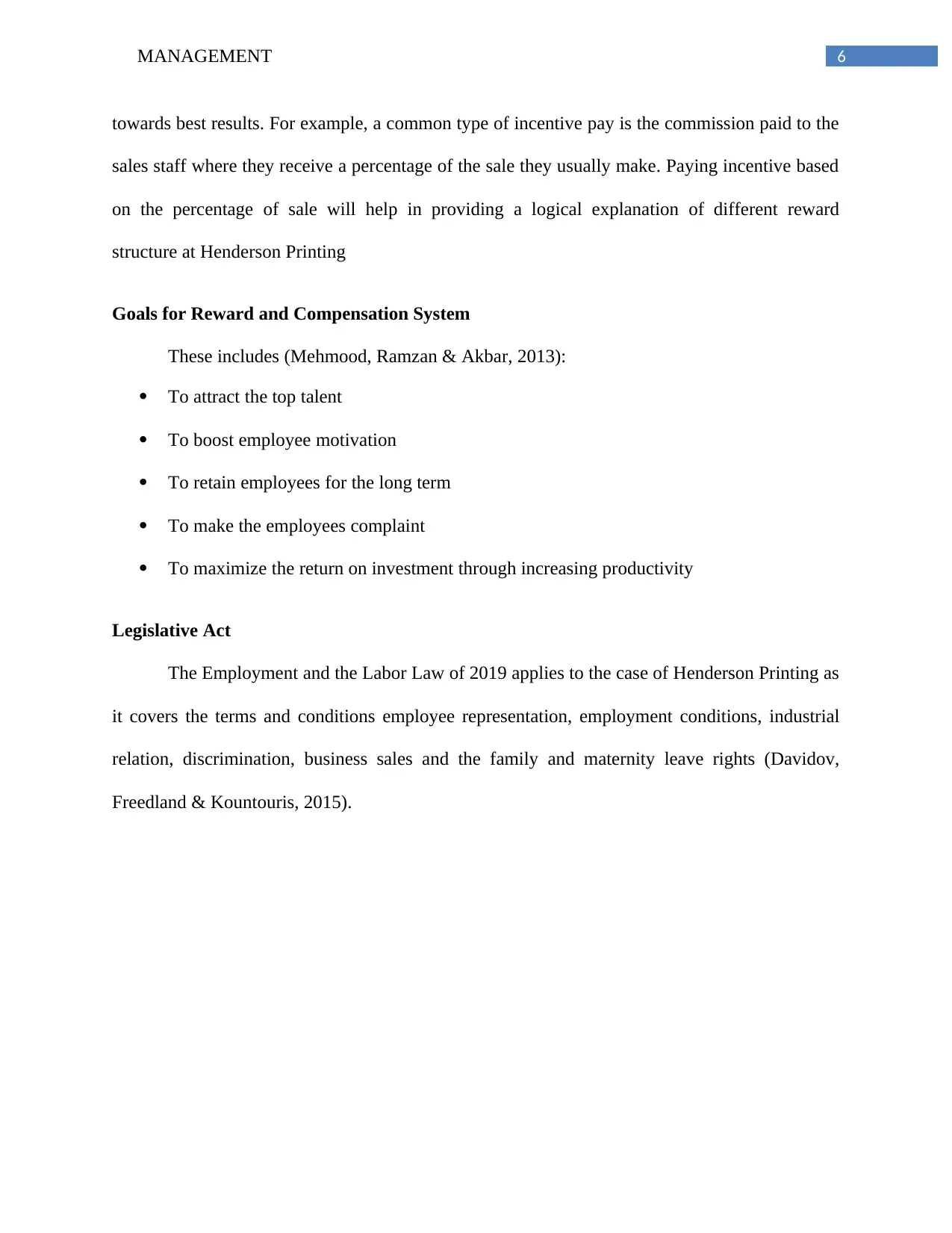
6MANAGEMENT
towards best results. For example, a common type of incentive pay is the commission paid to the
sales staff where they receive a percentage of the sale they usually make. Paying incentive based
on the percentage of sale will help in providing a logical explanation of different reward
structure at Henderson Printing
Goals for Reward and Compensation System
These includes (Mehmood, Ramzan & Akbar, 2013):
To attract the top talent
To boost employee motivation
To retain employees for the long term
To make the employees complaint
To maximize the return on investment through increasing productivity
Legislative Act
The Employment and the Labor Law of 2019 applies to the case of Henderson Printing as
it covers the terms and conditions employee representation, employment conditions, industrial
relation, discrimination, business sales and the family and maternity leave rights (Davidov,
Freedland & Kountouris, 2015).
towards best results. For example, a common type of incentive pay is the commission paid to the
sales staff where they receive a percentage of the sale they usually make. Paying incentive based
on the percentage of sale will help in providing a logical explanation of different reward
structure at Henderson Printing
Goals for Reward and Compensation System
These includes (Mehmood, Ramzan & Akbar, 2013):
To attract the top talent
To boost employee motivation
To retain employees for the long term
To make the employees complaint
To maximize the return on investment through increasing productivity
Legislative Act
The Employment and the Labor Law of 2019 applies to the case of Henderson Printing as
it covers the terms and conditions employee representation, employment conditions, industrial
relation, discrimination, business sales and the family and maternity leave rights (Davidov,
Freedland & Kountouris, 2015).
Paraphrase This Document
Need a fresh take? Get an instant paraphrase of this document with our AI Paraphraser
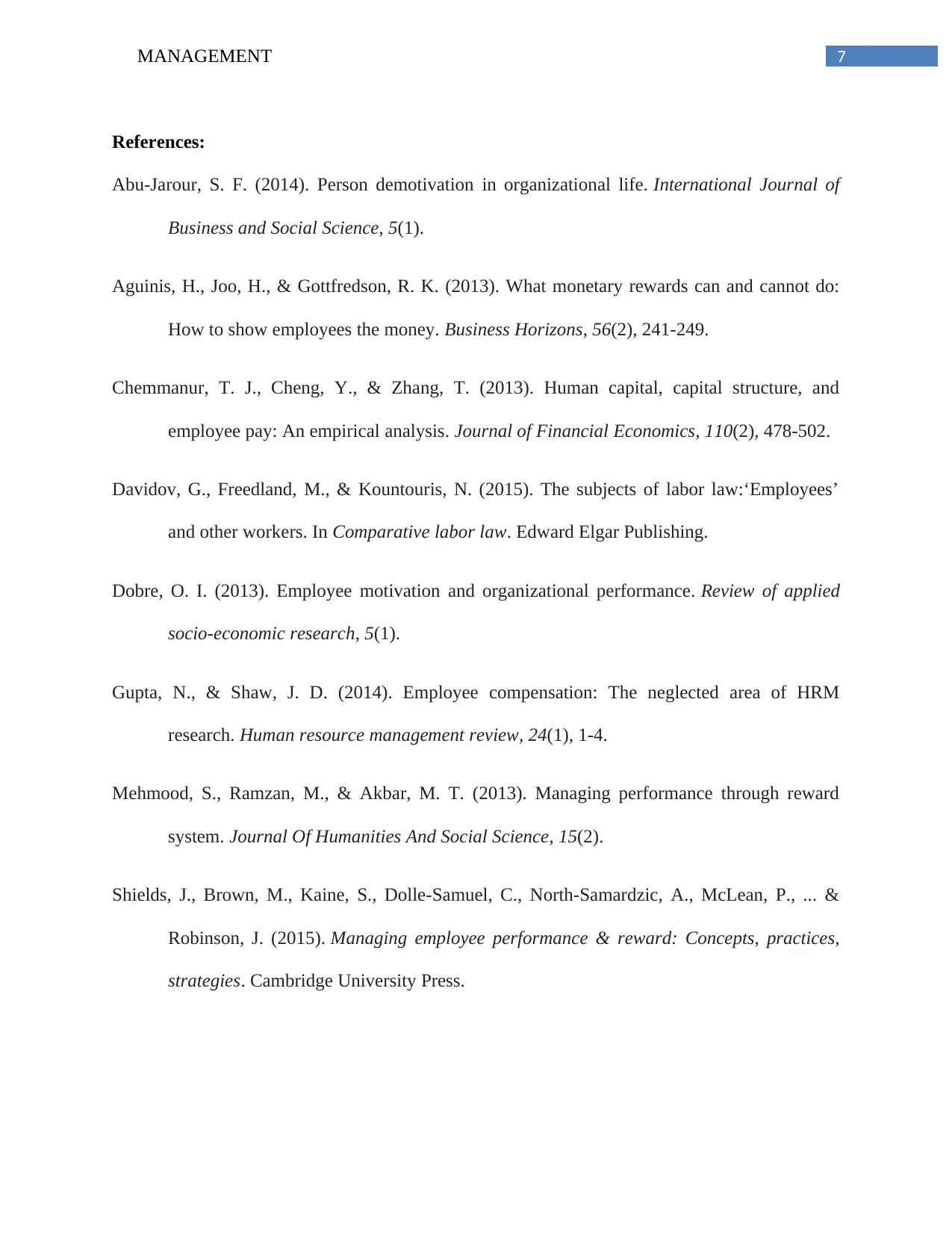
7MANAGEMENT
References:
Abu-Jarour, S. F. (2014). Person demotivation in organizational life. International Journal of
Business and Social Science, 5(1).
Aguinis, H., Joo, H., & Gottfredson, R. K. (2013). What monetary rewards can and cannot do:
How to show employees the money. Business Horizons, 56(2), 241-249.
Chemmanur, T. J., Cheng, Y., & Zhang, T. (2013). Human capital, capital structure, and
employee pay: An empirical analysis. Journal of Financial Economics, 110(2), 478-502.
Davidov, G., Freedland, M., & Kountouris, N. (2015). The subjects of labor law:‘Employees’
and other workers. In Comparative labor law. Edward Elgar Publishing.
Dobre, O. I. (2013). Employee motivation and organizational performance. Review of applied
socio-economic research, 5(1).
Gupta, N., & Shaw, J. D. (2014). Employee compensation: The neglected area of HRM
research. Human resource management review, 24(1), 1-4.
Mehmood, S., Ramzan, M., & Akbar, M. T. (2013). Managing performance through reward
system. Journal Of Humanities And Social Science, 15(2).
Shields, J., Brown, M., Kaine, S., Dolle-Samuel, C., North-Samardzic, A., McLean, P., ... &
Robinson, J. (2015). Managing employee performance & reward: Concepts, practices,
strategies. Cambridge University Press.
References:
Abu-Jarour, S. F. (2014). Person demotivation in organizational life. International Journal of
Business and Social Science, 5(1).
Aguinis, H., Joo, H., & Gottfredson, R. K. (2013). What monetary rewards can and cannot do:
How to show employees the money. Business Horizons, 56(2), 241-249.
Chemmanur, T. J., Cheng, Y., & Zhang, T. (2013). Human capital, capital structure, and
employee pay: An empirical analysis. Journal of Financial Economics, 110(2), 478-502.
Davidov, G., Freedland, M., & Kountouris, N. (2015). The subjects of labor law:‘Employees’
and other workers. In Comparative labor law. Edward Elgar Publishing.
Dobre, O. I. (2013). Employee motivation and organizational performance. Review of applied
socio-economic research, 5(1).
Gupta, N., & Shaw, J. D. (2014). Employee compensation: The neglected area of HRM
research. Human resource management review, 24(1), 1-4.
Mehmood, S., Ramzan, M., & Akbar, M. T. (2013). Managing performance through reward
system. Journal Of Humanities And Social Science, 15(2).
Shields, J., Brown, M., Kaine, S., Dolle-Samuel, C., North-Samardzic, A., McLean, P., ... &
Robinson, J. (2015). Managing employee performance & reward: Concepts, practices,
strategies. Cambridge University Press.
1 out of 8
Related Documents
Your All-in-One AI-Powered Toolkit for Academic Success.
+13062052269
info@desklib.com
Available 24*7 on WhatsApp / Email
![[object Object]](/_next/static/media/star-bottom.7253800d.svg)
Unlock your academic potential
Copyright © 2020–2025 A2Z Services. All Rights Reserved. Developed and managed by ZUCOL.

